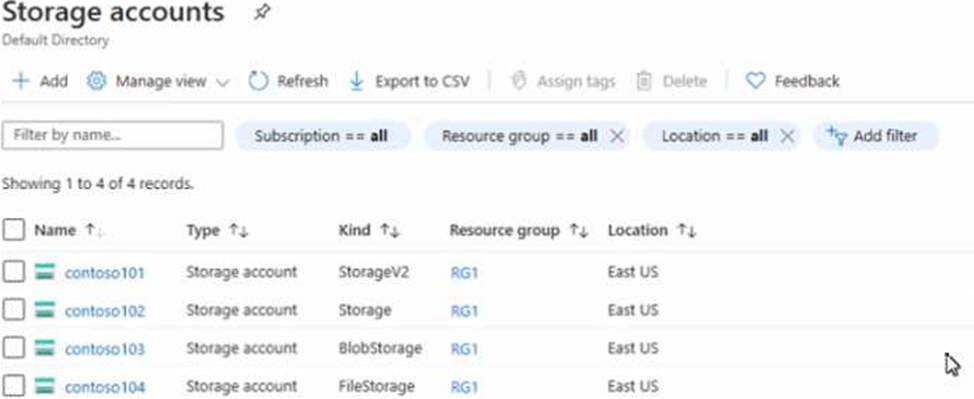Practice Free AZ-104 Exam Online Questions
Question #131
You have a virtual network named VNet1 as shown in the exhibit. (Click the Exhibit tab.)

No devices are connected to VNet1.
You plan to peer VNet1 to another virtual network named VNet2. VNet2 has an address space of 10.2.0.0/16.
You need to create the peering.
What should you do first?
- A . Configure a service endpoint on VNet2.
- B . Modify the address space of VNet1.
- C . Add a gateway subnet to VNet1.
- D . Create a subnet on VNet1 and VNet2.
Correct Answer: B
B
Explanation:
To create a peering between two virtual networks, the address spaces of the virtual networks must not overlap. VNet1 has an address space of 10.0.0.0/16, which overlaps with VNet2’s address space of 10.2.0.0/16. Therefore, you need to modify the address space of VNet1 to a non-overlapping range, such as 10.1.0.0/16, before you can create the peering. You do not need to configure a service endpoint, add a gateway subnet, or create a subnet on either virtual network for the peering to work. Then,
Reference: [Virtual network peering] [Modify a virtual network’s address space]
B
Explanation:
To create a peering between two virtual networks, the address spaces of the virtual networks must not overlap. VNet1 has an address space of 10.0.0.0/16, which overlaps with VNet2’s address space of 10.2.0.0/16. Therefore, you need to modify the address space of VNet1 to a non-overlapping range, such as 10.1.0.0/16, before you can create the peering. You do not need to configure a service endpoint, add a gateway subnet, or create a subnet on either virtual network for the peering to work. Then,
Reference: [Virtual network peering] [Modify a virtual network’s address space]
Question #132
You have an Azure AD tenant that is linked to 10 Azure subscriptions.
You need to centrally monitor user activity across all the subscriptions.
What should you use?
- A . Activity log filters
- B . Log Analytics workspace
- C . access reviews
- D . Azure Application Insights Profiler
Correct Answer: B
B
Explanation:
https://learn.microsoft.com/en-us/azure/azure-monitor/essentials/activity-log?tabs=powershell#send-to-log-analytics-workspace Send the activity log to a Log Analytics workspace to enable the Azure Monitor Logs feature, where you: – Consolidate log entries from multiple Azure subscriptions and tenants into one location for analysis together.
B
Explanation:
https://learn.microsoft.com/en-us/azure/azure-monitor/essentials/activity-log?tabs=powershell#send-to-log-analytics-workspace Send the activity log to a Log Analytics workspace to enable the Azure Monitor Logs feature, where you: – Consolidate log entries from multiple Azure subscriptions and tenants into one location for analysis together.
Question #133
HOTSPOT
You have an Azure subscription that contains the storage accounts shown in the following exhibit.


Correct Answer:


Question #134
You need to move the blueprint files to Azure.
What should you do?
- A . Generate a shared access signature (SAS). Map a drive, and then copy the files by using File Explorer.
- B . Use the Azure Import/Export service.
- C . Generate an access key. Map a drive, and then copy the files by using File Explorer.
- D . Use Azure Storage Explorer to copy the files.
Correct Answer: D
D
Explanation:
Azure Storage Explorer is a free tool from Microsoft that allows you to work with Azure Storage data on Windows, macOS, and Linux. You can use it to upload and download data from Azure blob storage.
Scenario:
Planned Changes include: move the existing product blueprint files to Azure Blob storage.
Technical Requirements include: Copy the blueprint files to Azure over the Internet.
Reference: https://docs.microsoft.com/en-us/azure/machine-learning/team-data-science-process/move-data-to-azure-blob-using-azure-storage-explorer
D
Explanation:
Azure Storage Explorer is a free tool from Microsoft that allows you to work with Azure Storage data on Windows, macOS, and Linux. You can use it to upload and download data from Azure blob storage.
Scenario:
Planned Changes include: move the existing product blueprint files to Azure Blob storage.
Technical Requirements include: Copy the blueprint files to Azure over the Internet.
Reference: https://docs.microsoft.com/en-us/azure/machine-learning/team-data-science-process/move-data-to-azure-blob-using-azure-storage-explorer
